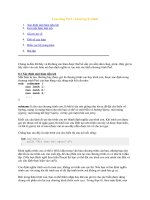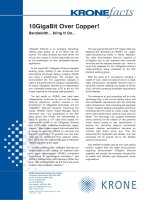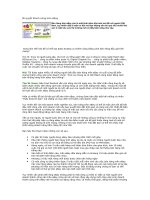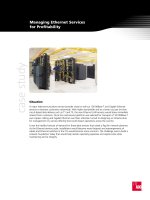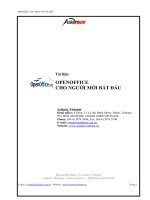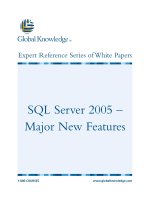Tài liệu Actual Test 642-641 v01.16.04 pptx
Bạn đang xem bản rút gọn của tài liệu. Xem và tải ngay bản đầy đủ của tài liệu tại đây (416.38 KB, 30 trang )
Exam: 642-641
Title : Quality of Service Exam (QoS)
Ver : 01.16.04
642-641
Actualtests.com - The Power of Knowing
QUESTION 1 Per-VC congestion avoidance discard at Layer 2 has what consequence when the ingress ATM
interface discards a fragment?
A. Incomplete data packets are sent and the entire data packet must be resent.
B. The entire data packet is discarded at the ingress interface and must be resent.
C. Incomplete data packets are sent and the discarded packet fragments must be resent.
D. Data packets may be sent in cells that are out of order, causing the entire packet to be resent.
Answer: D
QUESTION 2 Why do real-time applications like VoIP require better service than traditional best effort
services? (Choose three)
A. These applications are sensitive to jitter.
B. These applications are sensitive to delays.
C. Real-time applications are sensitive to packet drops.
D. Real-time applications are typically non-interactive and use mostly bulk data transfer.
E. Real-time applications typically require RSVP which cannot be run on a network using best-effort services.
Answer: A, B, E
QUESTION 3 Which statement is true about policing traffic conditions in IP QoS?
A. Policing reorders transmit queues to offer priority service to specific traffic flows.
B. Policing utilizes buffers to delay excessive traffic when the flow is higher than expected.
C. Policing techniques monitor network traffic loads in an effort to anticipate and avoid congestion.
D. Policing allows the network administrators to traffic engineer paths through the network for application
flows.
E. Policing is the ability to control bursts and conform traffic to ensure certain traffic types receive specified
amounts of bandwidth.
Answer: E
QUESTION 4 What is a limiting factor of IntServ scalability in large networks?
A. IntServ admission control must be implemented locally on all the routers.
B. MPLS/TE tunnels cannot be established through an MPLS network using RSVP.
C. IntServ requires the routers to track a large amount of per-flow state information.
D. IntServ requires all the routers to identify common flows that require the same service into a traffic
aggregate.
E. The IntServ QoS mechanism used to apply the appropriate per-hop behavior (PHB) must be implemented on
all the routers.
Answer: D
QUESTION 5 Which three Cisco IOS QoS mechanisms have marking capabilities? (Choose three)
A. PBR
B. Committed Access Rate (CAR)
C. Weighted Random Early Detection (WRED)
D. QoS Policy Propagation through BGP (QPPB)
E. Class-Based Weighted Fair Queuing (CBWFQ)
Answer: B, C, E
642-641
Actualtests.com - The Power of Knowing
QUESTION 6 How does Low Latency Queuing (LLQ) differ from IP Real-Time Transport Protocol (RTP)
priority?
A. LLQ is not limited to defining traffic flows using UDP port numbers.
B. IP RTP Priority can specify traffic matches based on DSCP whereas LLQ cannot.
C. LLQ is well suited for voice traffic that is not supported in IP RTP Priority configurations.
D. LLQ priority queues suffer from "starvation" of low priority traffic due to preferential treatment of the high
priority queue.
Answer: A
QUESTION 7 What are two important benefits of applying QoS to IP networks? (Choose two)
A. QoS manages packet loss during periods of bursty congestion.
B. QoS allows network managers to control usage patterns of network applications.
C. QoS can solve traffic problems on low bandwidth, high-latency, high-loss WAN links.
D. QoS facilitates the integration of differing traffic types such as voice, video, and data into a single
infrastructure.
E. QoS can provide performance enhancements for commercial application issues such as server sizing and
tuning.
Answer: C, D
QUESTION 8 What allows the Differential Services model to be scaled to large networking environments?
A. Differential services are accomplished through hop-by-hop application signaling.
B. The Differentiated Services model scales by providing per-flow state visibility to the core of the network.
C. Policing is not used in the Differentiated Services model providing for efficient expediting of high priority
traffic flows.
D. It achieves scalability by implementing complex classification and conditioning requirements only at
network boundary nodes.
E. In the Differentiated Services model, and explicit setup mechanism predefines all QoS parameters for the
packet before it is transmitted.
Answer: E
QUESTION 9 Exhibit:
interface Serial 0/1/0
ip address 10.1.1.1 255.255.255.0
random-detect
random-detect precedence 0 1 2 1
random-detect precedence 0 10 20 10
random-detect precedence 2 15 20 10
random-detect precedence 3 20 30 10
random-detect precedence 4 25 30 10
random-detect precedence 5 30 40 10
random-detect precedence 6 35 40 50
random-detect precedence 7 35 40 100
random-detect exponential-weighted-constant 11
Based on the configuration in the exhibit, which statement is true?
A. The drop probability of precedence 0 traffic is 100%.
B. The drop probability of precedence 1-5 traffic is 100%.
642-641
Actualtests.com - The Power of Knowing
C. The drop probability of precedence 5 traffic is 100%.
D. The drop probability of precedence 7 traffic is 100%.
Answer: C
QUESTION 10 What is an important advantage of using Flow-based WRED (FRED) instead of standard
Weighted Random Early Detection (WRED)?
A. In Cisco IOS, FRED is easier to configure than WRED.
B. FRED can classify packets using DSCP and WRED cannot.
C. FRED adds support for new protocol and traffic types including UDP.
D. With FRED, packets are not dropped indiscriminate of the kind of flows to which the packets belong.
Answer: D
QUESTION 11 In Cisco's implementation of Weighted Random Early Detection (WRED), what can packet
drop decisions be based on? (Choose two)
A. DSCP
B. IP precedence
C. TCP window size
D. Interface buffer utilization
E. Interface output queue size
Answer: B
QUESTION 12 How does per-VC Class-Based Weighted Fair Queuing (CBWFQ) work?
A. A weight is assigned to the entire class, not to an individual flow.
Only one class can be assigned to each VC.
B. A weight is assigned to the entire class, not to an individual flow.
Multiple classes can be assigned to each VC.
C. Each flow within a class is assigned a separate weight by CBWFQ.
Only one class can be assigned to each VC.
D. Each flow within a class is assigned a separate weight by CBWFQ.
Multiple classes can be assigned to each VC.
Answer: C
QUESTION 13 Place the Random Early Detection (RED) profile parameters in the appropriate boxes.
Answer:
642-641
Actualtests.com - The Power of Knowing
QUESTION 14 Which statement is true about Frame Relay Fragmentation?
A. Voice packets are never fragmented.
B. FRF.11 Annex-C is used if VoFR is configured on the DLCI.
C. FRF.12 uses separate queues for voice and non-voice traffic.
D. All DLCIs on the same physical interface must use the same fragmentation scheme.
E. An interface uses FRF.11 Annex-C or FRF.12 fragmentation for non-voice traffic and FRF 3.1 encapsulation
for voice traffic.
Answer: D
QUESTION 15 What is the default MLP Link Fragmentation and Interleaving (LFI) serialization time?
A. 10 ms
B. 20 ms
C. 30 ms
D. 40 ms
E. 50 ms
Answer: B
QUESTION 16 When configuring Compressed Real-time Transport Protocol (RTP), what is the purpose of the
passive keyword?
A. All RTP packets are compressed, regardless of other parameters.
B. Outgoing RTP packets are compressed; incoming RTP packets do not need to be.
C. outgoing RTP packets are compressed only if incoming RTP packets are compressed.
D. Incoming RTP packets may be compressed; all outgoing RUP packets are not compressed.
Answer: A
QUESTION 17 Which two Cisco IOS-supported payload compression algorithms search the byte stream for
redundant strings, replacing them with shorter dictionary tokens? (Choose two)
A. Predictor
B. STAC (Stacker)
C. Diffie-Helman (DH)
D. Microsoft Point-to-Point Compression (MPPC)
Answer: A, C
QUESTION 18 RTP header compression can be used to reduce which three headers? (Choose three)
A. IP
B. UDP
C. RTP
D. TCP
E. PPP
Answer: A, B, C
QUESTION 19 When using Modular QoS Command Line Interface (MQC), traffic that does not have a match
is ______.
A. Ignored by the MQC
B. Dropped (implicit deny all)
642-641
Actualtests.com - The Power of Knowing
C. Placed in the default class
D. Process switched through the router
Answer: C
QUESTION 20 What purpose do polices in the Modular QoS Command Line Interface (MQC) serve?
A. They are used to bind polices to the interfaces.
B. They are used to define the polices for classifying data.
C. They are used to bind traffic classifications to QoS polices.
D. They are used to apply end-to-end polices in network devices.
Answer: C
QUESTION 21 Which three statements about class maps are true? (Choose three)
A. A class map can be configured within another class map.
B. Match commands are used to specify packet classification.
C. If match-any or match-all is not specified, the default behavior is match-any.
D. Traffic that does not have a match in the class map is placed in the default class.
Answer: B, C, D
QUESTION 22 What is the first step in building a service policy?
A. Use the qos-map command and specify the service policy name.
B. Use the policy-map command and specify the service policy name.
C. Use the policy-map command and specify the service policy name.
D. Use the service-policy command and specify the service policy name.
Answer: B, C
QUESTION 23 In relation to QoS, what is per-VC queuing?
A. The ability to apply polices per VC.
B. The ability to apply polices per VC bundle.
C. The ability to set the number of queues per VC.
D. The ability to set the queue depth and thresholds per VC.
Answer: D
QUESTION 24 What is Network-Based Application Recognition (NBAR)
A. NBAR is Cisco IOS software that can recognize applications that use dynamically assigned port numbers or
applied services (including QoS) to them.
B. NBAR is a network server that uses agents in the routers to monitor the network to catalog the application
traffic and applied services, including QoS.
C. NBAR is an application associated with RSVP that resides in the host computers and registers its network
applications with RSVP to allocate the necessary bandwidth for each.
D. NBAR is an application that searched the network servers to catalog the applications that use the network.
This can be used by the network administrator to apply services, including QoS.
Answer: C
QUESTION 25 What three steps are used to implement QoS using Modular QoS Command Line Interface
(MQC)? (Choose three)
A. Configure marking options using a route map.
642-641
Actualtests.com - The Power of Knowing
B. Configure classification options using a class map.
C. Select an output queuing strategy using a queue map.
D. Attach the QoS traffic policy to an interface in the inbound or outbound direction.
E. Configure a QoS traffic policy by associating a QoS traffic class with a QoS feature.
Answer: A, B, D
QUESTION 26 What is a purpose of the Cisco IOS Policy Propagation through BGP (QPPB) feature?
A. QPPB enables traffic shaping on BGP-enable WAN interfaces.
B. It propagates IP precedence or the QoS Group to destinations using BGP communities.
C. It allows non-CEF enabled routers to support QoS and BGP by tagging routes in the BGP table.
D. It provides flow-based Weighted Random Early Detection (WRED) support to external BGP peers.
E. It provides QoS policy in BGP networks by allowing centralized QoS configurations in BGP confederations.
Answer: D
QUESTION 27 What are two services provided through Committed Access Rate (CAR)? (Choose two)
A. Policing
B. Classification
C. Link efficiency
D. Traffic shaping
E. Weighted Random Early Discard (WRED)
Answer: D, E
QUESTION 28 Given the router configuration:
interface Ethernet 0
ip address 10.1.1.1 255.255.255.0
ip policy-map set-prec
!
route-map set-prec permit 10
match ip address 101
set ip precedence 1
!
route-map set-prec permit 20
set ip precedence 0
!
access-list 101 permit tcp any any eq telnet
!
Which of the following statements is true?
A. All telnet packets from the Ethernet 0 interface are marked with IP precedence 0.
B. All non-telnet traffic from the Ethernet 0 interface is marked with IP precedence 0.
C. All packets sourced locally by the router that goes out on the Ethernet 0 interface are marked with IP
precedence 1.
D. All telnet packets sourced locally by the router that goes out on the Ethernet 0 interface are marked with IP
precedence 1.
Answer: D
642-641
Actualtests.com - The Power of Knowing
QUESTION 29 When configuring policy-based routing on Cisco IOS routers, which three steps are required?
(Choose three)
A. Assign the policy to an interface.
B. Enable local policy-based routing.
C. Enable fast-switched policy-based routing.
D. Specify the match criteria and resulting action.
E. Define a route map to be used by policy-based routing.
Answer: A, D, E
QUESTION 30 What is the effect of enabling Weighted Fair Queuing (WFQ) on a low-speed router interface?
A. Delay is guaranteed for high-priority traffic types.
B. Bandwidth is guaranteed for different traffic queues.
C. Fixed-size queues are pre-allocated for different traffic flows.
D. Low-bandwidth traffic receives priority over high-bandwidth traffic.
Answer: C
QUESTION 31 When would Cisco IOS bypass the transmit software queue on an interface and place the
packet directly into the hardware queue?
A. When LLQ has been enabled.
B. When the software queue is full.
C. When the software queue is empty.
D. When the software queue has reached its MCC.
Answer: A
QUESTION 32 Which statement is true about the queuing scheme of IP Real Time Transport Protocol (RTP)
prioritization?
A. It supports TCP traffic.
B. It is usually used for interactive traffic.
C. It provides low latency queuing by providing a high priority queue.
D. Packets that exceed the queue's configured rate are placed into the default queue.
Answer: A
QUESTION 33 What are two version of distributed WFQ (dWFQ)? (Choose two)
A. flow-based dWFQ
B. ToS-based dWFQ
C. CAR-based dWFQ
D. QPPB-based dWFQ
E. DiffServ-based dWFQ
F. precedence-based dWFQ
Answer: D, E
QUESTION 34 Which bit in the ATM header can be marked by the Class Based Marker to extend IP QoS
policy into an ATM network?
A. DE
B. PTI
C. CLP
642-641
Actualtests.com - The Power of Knowing
D. BECN
E. FECN
Answer: C
QUESTION 35 What can happen when you properly configure Priority Queuing on Cisco IOS routers?
A. A starvation condition can occur in which lower priority queues are never serviced.
B. Priority Queuing overhead can be too great for slow WAN link, causing buffer exhaustion.
C. The high priority queue has a default queue limit of 80, that can result in excessive packet loss.
D. By default, unclassified packets are placed into the high priority output queue, which can affect high priority
traffic.
Answer: D
QUESTION 36 Exhibit:
interface s0/0
custom-queue-list 5
!
queue-list 5 protocol ip 1 list 101
queue-list 5 queue 1 limit 40
queue-list 5 lowest-custom 2
queue-list 5 interface e0/0 2
queue-list 5 queue 2 byte-count 5000
queue-list 5 protocol ip 3
queue-list 5 queue 3 byte-count 5000
queue-list 5 queue 4 default
!
access-list 101 permit ip any any precedence 5
Given the configuration in the exhibit, which queue is used for traffic from e0/0 with a precedence of five?
A. 1
B. 2
C. 3
D. 4
Answer: B
QUESTION 37 Which statement is true about how Priority Queuing services its queues?
A. The highest priority queue containing packets is serviced until it is empty.
B. The highest priority queue is always serviced first.
The remaining queues are serviced in a TDM fashion.
C. A high priority queue is serviced until it is empty, then the service engine moves to the next highest priority
queue in a round-robin fashion.
D. The highest priority queue is allocated 50% of the available bandwidth.
Each remaining queue is allocated 50& of the remaining bandwidth.
Answer: B
QUESTION 38 By default, what scheduling mechanism does Custom Queuing use?
A. FIFO
B. top down
642-641
Actualtests.com - The Power of Knowing
C. weighted
D. round robin
Answer: C
QUESTION 39 What two operating modes are supported by the Modified Deficit Round Robin (MDRR)
service algorithm? (Choose two)
A. FIFO
B. strict priority
C. shared priority
D. alternate priority
E. weighted priority
Answer: C, E
QUESTION 40 What is a drawback if FIFO queuing?
A. It can produce excessive jitter.
B. It only supports a queue size of 40 packets.
C. It only supports packet classification based upon traffic flows.
D. It is only available on interfaces that operate at 2 Mbps or higher.
Answer: D
QUESTION 41 Exhibit:
interface s0/0
bandwidth 128
ip address 10.0.0.1 255.255.255.252
encapsulation ppp
fair-queue
ip rtp priority 16384 16383 50
Given the configuration in the exhibit, how much bandwidth is available to the fair queues?
A. 46 Kbps
B. 50 Kbps
C. 65 Kbps
D. 78 Kbps
E. 128 Kbps
Answer: B
QUESTION 42 During periods of traffic congestion, which packet will Weighted Fair Queuing (WFQ) drop?
A. The newest packet.
B. The largest packet.
C. The packet with the lowest priority.
D. The packet with the worst finish time.
Answer: A
QUESTION 43 Why is Weighted Fair Queuing (WFQ) disabled on WAN interfaces using X.25, SDLC,
LAPB, or reliable PPP encapsulations?
A. These protocols require strict priority scheduling which is not supported by WFQ.
B. These encapsulations require sequenced packets which is contradictory to WFQ operation.
642-641
Actualtests.com - The Power of Knowing
C. Each of these protocols has a pre-defined queuing scheme that must be used with that protocol.
D. These protocols require delay characteristics which cannot be met by WFQ-enabled routers.
Answer: A
QUESTION 44 Which three markers can be set by Committed Access Rate (CAR)? (Choose three)
A. DSCP bits
B. QoS Group
C. ATM CLP bit
D. IP precedence bits
E. Frame Relay DE bit
Answer: C, D, E
QUESTION 45 Why is DiffServ model more scalable than the IntServ model? (Choose two)
A. DiffServ uses per-aggregate QoS instead of per-flow QoS.
B. DiffServ routers do not have to track the state information for each individual flow.
C. DiffServ uses hop-by-hop signaling which allows DiffServ to scale to a larger number of application flows.
D. DiffServ can implement admission control either locally on the routers or be offloaded to a central policy
server using the COPS protocol.
Answer: C
QUESTION 46 What are two benefits of using traffic shaping to implement network rate limiting? (Choose
two)
A. Traffic shaping is an effective tool for rate-limiting VoIP traffic.
B. Rate limiting with traffic shaping does not increase packet loss.
C. Rate limiting with traffic shaping does not add to packet transit delays.
D. Traffic shaping can interact with congestion mechanisms embedded in Frame Relay.
E. Traffic shaping can be used on a router in either the inbound or outbound direction.
Answer: A, E
QUESTION 47 Exhibit:
Router# show interfaces hssi 0/0/0 rate-limit
Hssi0/0/0 45Mbps to R1
Input
matches: all traffic
params: 20000000 bps, 24000 limit, 24000 extended limit
conformed 8 packets, 428 bytes; action: transmit
exceed 0 packets, 0 bytes; action: drop
last packet: 8680ms ago, current burst: 0 bytes
last cleared 00:03:59 ago, conformed 0 bps, exceed 0 bps
Output
matches: all traffic
params: 20000000 bps, 24000 limit, 24000 extended limit
conformed 0 packets, 0 bytes; action: transmit
exceed 0 packets, 0 bytes; action; drop
last packet: 8680ms ago, current burst: 0 bytes
last cleared 00:03:59 ago, conformed 0 bps, exceed 0 bps
642-641
Actualtests.com - The Power of Knowing
The router in the exhibit has been configured with Committed Access Rate (CAR) to rate limit traffic.
What data rate has the traffic been limited to?
A. 192 Kbps
B. 2400 Kbps
C. 4,5 Mbps
D. 20 Mbps
E. 40 Mbps
Answer: B
QUESTION 48 Frame Relay Traffic Shaping (FRTS) is implemented along with which type of software
queuing mechanism on the physical interface?
A. FIFO
B. Priority Queuing (PQ)
C. Custom Queuing (CQ)
D. Weighted Fair Queuing (WFQ)
E. IP Real Time Transport Protocol (RTP) Priority
Answer: B
QUESTION 49 What is a benefit of Enhanced LMI (ELMI) on Cisco networks?
A. ELMI provides virtual provisioning tools at the edge of the Frame Relay network.
B. ELMI enables the router to use additional QoS tools including rate limiting with CAR
and the Modular QoS Command Line Interface (MQC).
C. ELMI allows the router to deliver packets at the line rate of the Frame Relay interface,
regardless of the condition of the Frame Relay network.
D. ELMI allows routers to dynamically download QoS information from Cisco switches
for use in traffic shaping or for congestion management purposes.
Answer: B
QUESTION 50 Exhibit:
<output omitted>
!
interface Ethernet0/0
ip address 161.24.52.1 255.255.255.0
traffic-shape group 101 1000000 125000 125000
!
interface Ethernet0/1
ip address 161.24.53.1 255.255.255.0
traffic-shape rate 5000000 625000 625000
!
access-list 101 permit udp any any
!
<output omitted>
How does the configuration shown in the exhibit affect traffic leaving the router? (Choose two)
A. All traffic leaving interface Ethernet 0/0 is rate limited to 1 Mbps.
B. All traffic leaving interface Ethernet 0/1 is rate limited to 5 Mbps.
C. All UDP traffic that enters interface Ethernet 0/0 is rate limited to 1 Mbps.

